Orsay Museum Private Guided Tour
Our Orsay Museum Tour is a private guided tour in which our fully licensed guide Lecturer will help you to make the most of your visit to the Musée d’Orsay, the most beloved one in Paris.
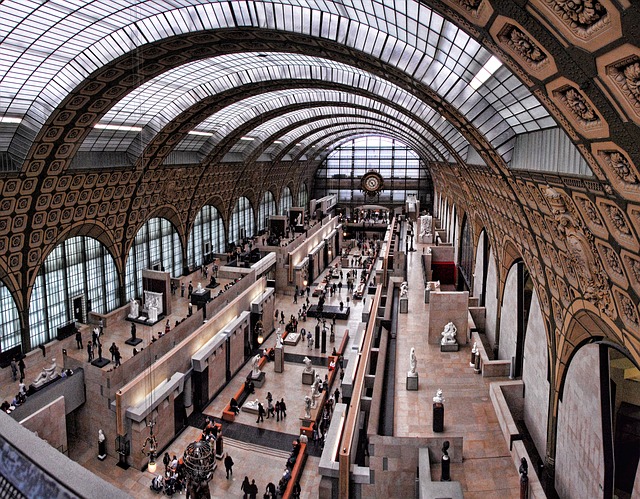
Orsay Tour: The main hall of the Orsay Museum. This open space illuminated by the natural light from the huge barrel vault glass roof is dedicated to sculptures meanwhile paintings are installed in lateral rooms where they are protected from direct bright light.
Orsay Museum Private Guided Tour essentials
From 130 € for 1 to 2 people + 30 € per extra personn
- +/- 2 hours guided tour in English
- Really private tour = your party only (6 people max.)
- Postgraduate (MPhil) certified French national guide
- Flexible time schedule – Evening Tours on Thursdays
- Not available on Sundays & Mondays
- Skip-the-line ticket to buy online (16 € per adult)
Skip-the-line-tickets clarification: they are just standard online tickets.
Hint: Guided tours in Orsay are forbidden on Sundays & during bank holidays.
KNOW MORE / BOOK NOW
For a full French painting introduction follow the Louvre French paintings tours cycle 14th to 19th centuries before your Orsay tour. As a complement to the Orsay tour also see our Van Gogh in Auvers or our Saint-Germain-des-Près & fine arts tours.
What’s the tour about?
Before Impressionism
Impressionism
After Impressionism
Transgression
Light
Inovation
Color
Air
Tour Synthesis
Explore art evolution from Academicism to Impressionism et Post-Impressionism. Figure out how and why the impressionist art revolution happened in Paris in the 19th century. Discover the main masterpieces of Édouard Manet, Claude Monet, Auguste Renoir, Camille Pissaro, Edgar Degas, Berthe Morisot, or Mary Cassatt. Understand impressionism’s key factors of success in Paris and the USA. Identify posterior art transformation with Post-Impressionists as Paul Cézanne, Georges Seurat, Paul Signac, Paul Sérusier, Vincent Van Gogh, or Paul Gauguin.
Tour MasterPieces
Paintings hanging change quite often in Orsay and the tour route is subject to contingencies, nevertheless here are some examples of masterpieces you can expect to see during the tour: Olympia, Le déjeuner sur l’herbe (Édouard Manet); Poppies, Blue Water-Lilies (Claude Monet); Bal du moulin de la Galette, Dance in the Country (Auguste Renoir); Red roofs in the corner of the village, La Seine et le Louvre (Pissaro); Young Woman Sewing in a Garden (Mary Cassatt); L’Absinthe, La classe de danse (Edgar Degas); The Cardplayers (Paul Cézanne); Circus (Georges Seurat); The Talisman (Paul Sérusier); Thatched Cottage at Cordeville, Portrait du Docteur Gachet (Vincent Van Gogh); Le Cheval blanc, Arearea (Paul Gauguin) and lot more!
What’s about Van Gogh in the Orsay Tour?
If Van Gogh means a lot to you, just tell your guide at the beginning of the tour, and he will shortcut some content of the preimpressionist period to be able to dedicate more time to speaking about Vincent. It is not a problem for our guide as he is the one who curated the content of our 4 hours Van Gogh at Auvers-sur-Oise tour.
Your Private Orsay Museum Tour Guide
Certified French national guide
BA, Magna Cum Laude, Heritage Developpement & Preservation from Conservatoire des Arts et Métiers
Postgraduate from Paris Dauphine-PSL University
Why Visit the Musée d’Orsay?
The Musée d’Orsay is the most famous one in Paris with Le Louvre. It houses modern art from 1848 to 1914. Orsay Museum’s impressionist and post-impressionist collections are the largest in the world!
The museum is also famous for its impressive collection of sculptures by artists as famous as Claudel, Bourdelle, Bartholdi, Daumier, Degas, etc., with a lot of masterpieces as for example the Gates of Hell by Rodin.
It is less known but Orsay Museum also exhibits an important collection of Art Nouveau furniture and houses a huge photography collection which is sadly very little shown.
A model of the Opéra Garnier is presented at the end of the main hall.
Last, the Orsay Museum regularly organizes first-class temporary exhibits of artworks by nineteenth-century artists.
Why an Orsay Museum Private Tour?
You will go straight to the main masterpieces by Manet, Courbet, Monet, Van Gogh, etc.
You will get an overview of French painting from 1850 to 1914; understand the Impressionist and Post-Impressionist revolution in art.
Skip-the-line tickets clarification
A skip-the-line ticket just means a ticket purchase online. So yes, you don’t line with those who come to Orsay without a ticket, but yes, you definitively line with all the others who have purchased their tickets online in advance like you! Your guide will line with you.
Warning about the crowded days at Orsay Museum
Crowd means a lot of time lost to enter the museum and a non-optimum experience, more specifically in the van Gogh paintings rooms. In case of a popular Orsay exhibition during the periode you plan to come, you better choose very carefully your day of visit. More generaly avoid high-season, French bank holidays, the first Sunday of the month (Orsay is free for all), or the Thursdays as the Louvre is closed more people usually come to Orsay.
Orsay Evening Tour
To make the most of your Orsay Museum Discovery, an evening tour is the best choice. Why visit Orsay during the most crowded hours when you can enjoy a quiet Orsay after-hour private tour.
Evening tours are possible on Thursdays as the museum starts to close its rooms from 9:30 PM instead of 5:30 PM the other days. For an evening tour, select Thursday on the booking calendar with a departure start between 6 and 7 PM (when the crowd starts to leave the museum).
Organization of the Tour
Our Orsay Tour is designed to give you a solid overview of the French painting of the 1848-1914 period, but is also an impressionism guided tour, organized chronologically around the core theme in three parts:
Part 1: Before Impressionism
Starting with the “Royal Academy of Painting and Sculpture” heirs, the “Salon de peinture“, with Ingres Neoclassism, Cabanel or Gérôme Academism.
We are ontinuing with impressionism precursors such as Delacroix’s Romanticism, Courbet’s Realism, and Barbizon school (Millet, Daubigny, Rousseau, etc.).
And then Boudin, master of Monet in Normandy, Corot often called the first of the impressionist and early Manet’s alla prima answer to Couture’s “finished painting” principles.
Part 2: Impressionism
Claude Monet, Frédéric Bazille, Auguste Renoir, Paul Cézanne, Alfred Sisley, Camille Pissaro, Édgard Degas, Gustave Caillebotte, etc.
Part 3: Neo-Impressionism & Post-Impressionism
Georges Seurat, Paul Signac, Vincent Van Gogh, Paul Gauguin, Odilon Redon, Henri de Toulouse-Lautrec, etc.

Orsay Private Guided Tour: the Impressionist Gallery, in the background Luncheon on the Grass by Édouard Manet © Musée d’Orsay / Sophie Crépy
Glimps of the Tour Content
Historical Context
- European Imperialism
- Opening of Japan to the outside world (1854)
- Rural flight (rural exodus) / Industrial Revolution
- Paris World’s Fairs
- Massive renovation of Paris
- Second French Empire (Napoléon III)
- Franco-Prussian War (July 1870-January 1871)
- French Third Republic (Belle Époque)
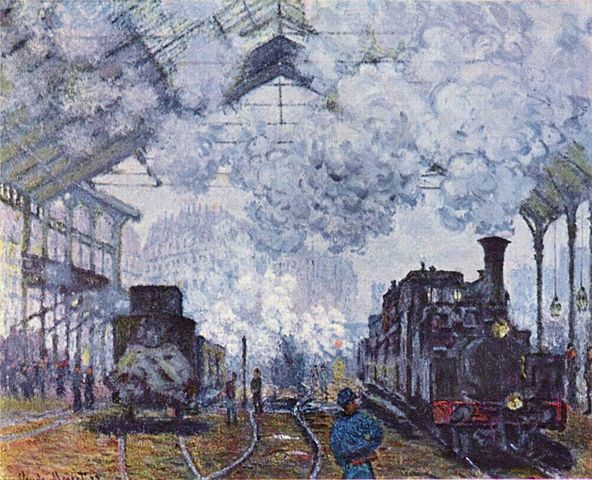
Monet displayed at least 8 versions of his Saint-Lazard Station at the 1877 third Impressionist exhibition. One is in Orsay. An iconic subject as depicting industrialization but also the train station to reach favorite painters places in Normandy and the north of Paris. Credit The Yorck Project – GNU Free Documentation License.
Art Evolution
Classification is not so easy in arts
Using a classification (before impressionism, impressionism, post-impressionism) makes things easier, but do not always work:
- Neoclassical Ingres, for instance is also a precursor of modern arts with his naked figures expressive distortions.
- Gustave Caillebotte (Impressionists patron, impressionist himself) most famous painting The Floor Scrapers is outstandingly realistic.
Our Orsay guided tour enlighten these kinds of questions and try to answer interesting matters as: was Degas or Manet impressionist?
Impact of Technical Innovations in Art
The 19th century is a century of innovation, but we will see in our Orsay Guided Tour that three of them drastically impact Art.
- Photography will influence painting, become art itself, and take to painting the lead in representing the real.
- The painting tube will ease the outdoor painting and authorize a full application of the new color theories.
- Synthetic pigments provided new shades of green, blue, and yellow never used by painters before.
Understand the evolution in the use of colors
In the 17th century Royal Academy of Painting and Sculpture members were discussing the respective value of drawing and color. Two centuries later the debate took a new dimension with “Principles of Harmony and Contrast of Colors” by Chevreul. Till Ingres was a drawing apostle, Delacroix was aware of color discoveries later used by Impressionists and Post-Impressionists like in:
- Poppies by Monet: contrast of complementary colors
- The Circus by Seurat: Divisionism and Pointillism
- The Talisman by Sérusier: Cloisonism and the triumph of color
Painters in this color revolution were also influenced by experimental works of Helmholtz or Ogden Rood who linked in his Modem Chromatics (1879) the new color theory with available pigments including the synthetic one’s brought by 19th-century innovation.
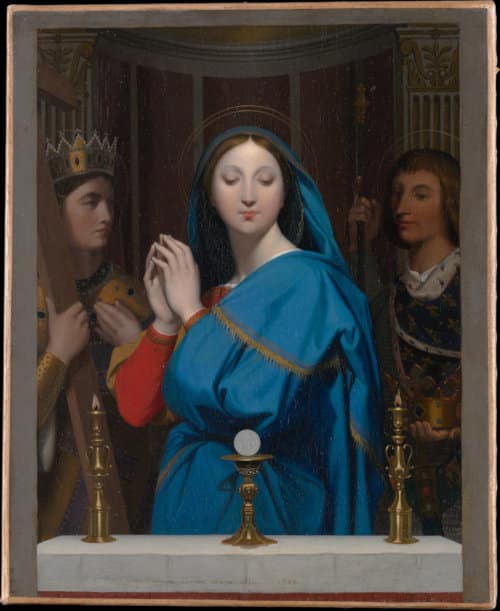
Painting by Ingres the apostle of the drawing.
Styles
- Neoclassicism (in reference to ancient Greece and Rome)
- Academism (the art of following rules and conventions)
- Romanticism (medievalism, imagination, and emotion)
- Orientalism (inspired by Egypt and Algeria expeditions)
- Realism (an expression of 19th-century society)
- Impressionism (our Orsay guided tour central subject!)
- Neo-Impressism (pointillism, chromoluminarism, etc.)
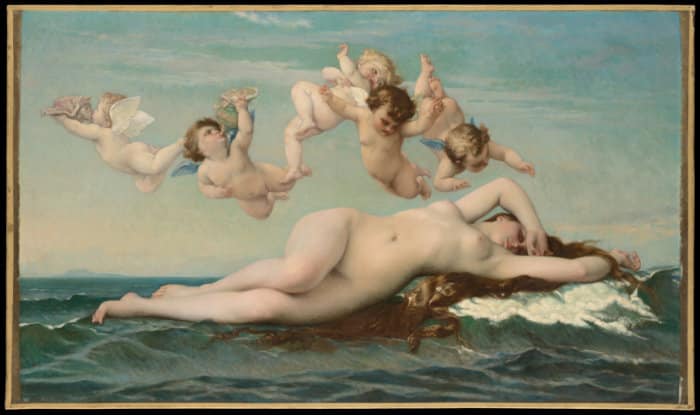
The birth of Venus by Cabanel, purchased by Emperor Napoleon III, the painting is a symbol, an icon of academism.
Social Relations Impact
The Key Role of an Impressionism Patron
Forward-thinking art dealer Paul Durand-Ruel had a major influence on Impressionist Art development. He bought hundreds of Renoir, Monet, Pissarro, etc. during his career and established impressionism popularity in the USA.
Consequently, remarkable impressionist collections are now in the USA; as the MET (New York Metropolitan Museum of Art) one with which we will do some parallels during our Orsay Guided Tour.
Influences Received by Impressionist & 19th-Century Artists
- Industrialization with its technical innovation and its human misery was a great subject of inspiration for the impressionists.
- Japonism with the influence ukiyo-e prints original use of color and composition on the work of impressionists and post-impressionists.
- Photography with multiple impacts, for example, the influence of Marey or Muybridge‘s photos on Degas for whom movement variation was a central theme as was light, air, and water for Monet.
Relations and Influences Between the Artists
Socially, all these painters were often also linked together, sometimes surprisingly as avant-garde Édouard Manet and academic Ernest Meissonier or Thomas Couture. They are also surprises speaking of influence between the artists like the one received by Pissaro and Monet during their 1870 stays in London, by Turner‘s light treatment, or Constable‘s use of emerald green. Van Gogh‘s tribute to Millet‘s Paysans painting is another interesting example.
The world of literacy was also linked with this art revolution via novelist Emile Zola or poet Charles Baudelaire.
Women and the 19th-Century Painting
You will also discover that some iconic painters of the period were women as Rosa Bonheur with her artistic Realism or Berthe Morisot, Eva Gonzalès, and the American Mary Cassat who actively participated in the impressionist revolution.
Geography of Impressionist & 19th Century Painting
Paris region with the Barbizon school; numerous places impressionist painters were fond of as Argenteuil, Pontoise or Auvers-sur-Oise also famous to be Van Gogh last place of residence where he painted 78 works in 70 days. Or also Éragny-sur-Epte, at Normandy limit where Pissaro experimented Divisionism.
Normandy: Region where begun Monet following Boudin. There is Giverny with Monet’s Water lily garden, but also Le Havre, the port of “Impression, Sunrise” and Rouen, city of the “Cathedral Series”.
Sud of France with Aix-en-Provence city of Cézanne and Zola, or Arles where Van Gogh looked for Japan’s light and meet Gaugin.
North Africa: Land of inspiration of Orientalism.
Orsay Tour Focus: the Master Pieces
Example of Masterpieces you Can Expect to See
Olympia by Manet or his no less famous Luncheon on the Grass (“Déjeuner sur l’herbe”), like the one by Monet are normally part of the tour. The Orsay Museum owns close to 80 Claude Monet paintings so we will show you more than one with:
- The Saint-Lazare Station, depicting modern life.
- Rouen Cathedral Series, light study.
- Blue Water Lilies, on the way to abstract arts.
Our Orsay Guided Tour Route will also cross Cézanne works as:
The Card Players, probably an adapted motif from Le Nain brothers’ 17th-century genre painting. One of the five versions of this canvas has been sold for around $250 million in 2011.
The Hanged Man’s House, presented at the 1874 first impressionist exhibit, shows the importance of volume for Cézanne. An aspect of his work that inspired Picasso and Braque in the early 20th century in a new art evolution called cubism.
The Hanged Man’s House still exists and is situated in the charming small town of Auvers-sur-Oise in the north of Paris, it is where Van Gogh spent the last days of his life.
Orsay’s Impressionist Masterpiece Example “Poppies” by Monet
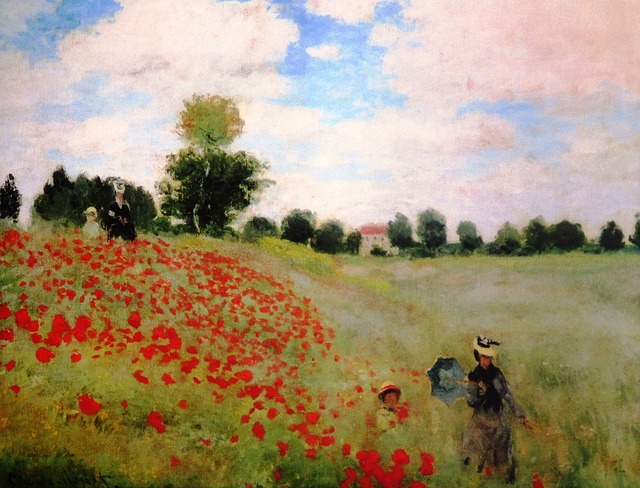
Poppies (“Coquelicot, la promenade”) by Claude Monet
Orsay Tour Focus: Van Gogh
The Orsay tour route normally ends in the newly installed (since 2019) post-impressionist gallery. There, in the two rooms dedicated to Van Gogh are usually shown most of the Orsay 27 van Gogh’s stellar paintings.
A few paintings are from Van Gogh’s early painting period in the Netherlands and some others are from his Parisian one.
But, the most famous Orsay’s Van Gogh paintings are from its later periods in the south of France and at Auvers-sur-Oise.
From Arles, Orsay owns Bedroom in Arles a masterpiece in which Van Gogh combines his passion for complementary colors and Japonism and Starry and Night over the Rhône one of the most famous Van Gogh’s masterpieces.
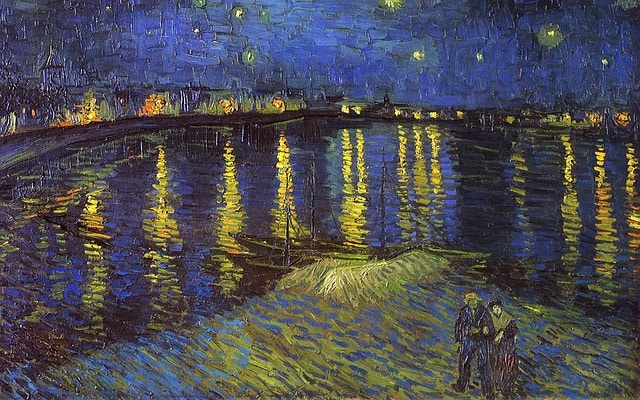
If the famous Starry Night by Vincent Van Gogh is visible in the MoMA (New York Museum of Modern Art), Starry Night Over the Rhône (“Nuit étoilée sur le Rhône“), is in Musée d’Orsay. The canvas depicts the reflections of the gas lighting, an expression of 19th-century innovation, across the dark blue water of the river.
The rest of the paintings originated from Docteur Gachet’s collection, the one who care for Van Gogh in the last 70 days of his life in Auvers-sur-Oise. At least 3 of them are also among Vincent most famous ones.
The Church in Auvers-sur-Oise differs from the impressionist works, as Van Gogh does not give the impression of a church but its expression anticipating fauvism or expressionism.
The Van Gogh’s self-portrait which was in Docteur Gachet’s Living Room in his house at Auvers, and last a portrait of Docteur Gachet painted by van Gogh in the same place.
If you are a Van Gogh enthusiast do not miss our Van Gogh in Auvers Walking Tour to discover the village, in which, at 35 Km in the north of Paris Vincent spent the 70 last days of his life, the most productive ones as he painted more than 70 masterpieces there.
Auvers-sur-Oise is a charming village (now a little city) beside the river Oise. It is one of the famous “painter’s villages” of the Paris region, not only linked with Van Gogh, but also with Cézanne, Pissarro, Daubigny, Corot, etc.

Photo of van Gogh painting “The Church in Auvers-sur-Oise, View from the Chevet”. The Yorck Project – GNU Free Documentation License.
More about the Musée d’Orsay
A Great View of Paris During Your Musée d’Orsay Private Tour
The Orsay Museum’s eastern big clock (5th floor just before the impressionists’ gallery) offers a great view of Paris with Le Louvre, Opera Garnier, Sacré-Coeur Basilica, and Montmartre, the place of the famous canvas “Moulin de la Galette” by Renoir.
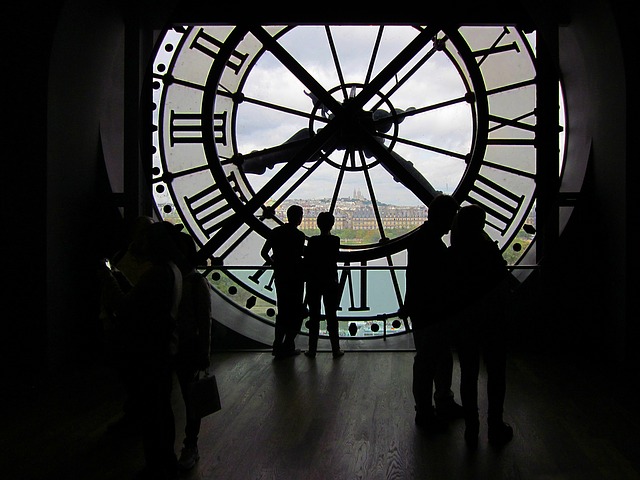
The Orsay Museum eastern big clock’s great view of Paris. The other Orsay clock is right after the impressionist rooms at Café Campana.
Musée d’Orsay a Former Train Station
The Musée d’Orsay is located along the River Seine, in a former train station, a fabulous looking 19th-century building designed by Architect V. Laloux for the “Paris, Exposition Universelle de 1900” using iron framing to maximize interior spaces and fenestration. Transformed by architect Gae Aulenty, the building was inaugurated as Musée d’Orsay in 1986.

Twilight view of the Orsay Museum along the Seine River. The architecture of this fabulous-looking 19th-century building is also part of the Orsay Guided Tour.
Around Our Orsay tour
The Orsay Tour: the Last Part of our French Paintings Tours Series
Also as a complement to our Orsay tour, we also propose a Saint-Germain-des-Prés fine arts and painting tour and a Van Gogh in Auvers-sur-Oise tour.
After Your Orsay Tour: What’s Around?
The Louvre and the Tuileries Gardens on the other bank of the Seine River are easily accessible via a walking bridge. Le Musée de l’Orangerie, in the Tuileries Gardens, shows water lily murals by Monet and has a great impressionist gallery.
Last, if you like the Napoleonic period the Musée de la Légion d’honneur is just in front of the Orsay Museum entrance parvis.
More Impressionism Places in Paris and Outside
In Paris Area
There is plenty of impressionism-related places in the Paris area as Montmartre district, Musée Marmottan, Musée Montmartre-Jardin Renoir, Musée Millet, Propriété Caillebotte, Musée Pissaro, Musée de la Grenouillère, Maison Van Gogh , etc. Do not hesitate to ask our Orsay Tour guide, he will be happy to inform you about it.
MuMa Impressionism Outside of Paris
For more impressionist painting, MuMa Musée d’art moderne André Malraux, exhibits the biggest impressionist collection in France after the Musée d’Orsay one. The Muma is situated in Le Havre, the port of “Impression, Sunrise” and houses works by Boudin, Monet, Manet, Guillaumin, Renoir, Pissarro, Sisley, Degas, Jongkind, etc., but also painting by Delacroix, Courbet, Corot, Matisse, Duffy, etc.
Thinks to Know Before Booking
Meeting Point
In front of the Orsay Museum by the rhino statue, rue de la Légion d’Honneur, 75007 Paris. Access: Métro Line 12 station Solférino. RER C station Musée d’Orsay.
Orsay-Tour Attention Points
- Prices do not include food, drinks or any other extra services.
- Tour duration and content are indicative. Visit may vary due to contingencies.
- Private tour means a tour for you & your party only, not that Orsay is privatized.
- Skip-the-line ticket means a ticket buy on line, nevertheless you still have to line for security and sanitary controls.
- Refund: if for any razon we are not able to do the tour, we refund the tour, but not the tickets.
Book Your Private Tour of Musée d’Orsay
Just request the date, time, number of people you want for your Orsay tour in our calendar and follow the below 4 steps online easy process.
(1) Receive our OK email (free reservation valid 48 hours)
(2) Buy your Orsay tickets on line (compatible schedule)
(3) Once you have your tickets pay your tour on line
(4) Receive our
confirmation (email)
- Nota bene : Step (1) free reservation is lost if no step (3) payment received after 48h.
- A full price online Orsay ticket is 16 €. Free for all kids under 18 years old, free under 26 years old for the European Union residents – Check last updated info and only buy your tickets on Orsay Museum web site.
Musée d'Orsay Private Tour
Extended tour (2 hours)For 1 to 2 people + 30 € for any extra person
A group of maximum 6 people exclusively yours
English language
Tickets not included

The Laundress is a realist painting by Daumier showing hard work in the cities meanwhile Millet was depicting the one of the fields. There are three versions of this canvas the MET one (here) is brighter than the Orsay one.
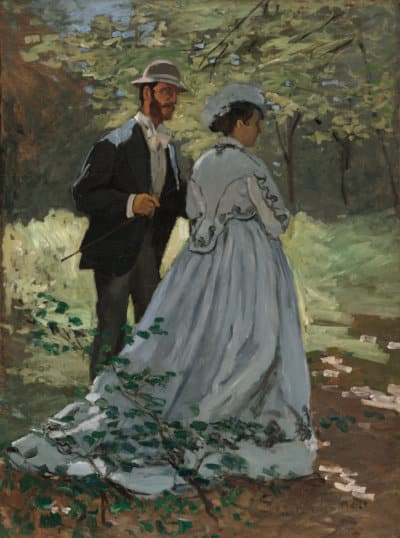
Orsay Museum Guided Tour: Bazille and Camille study for “Déjeuner sur l’herbe” by Monet.


